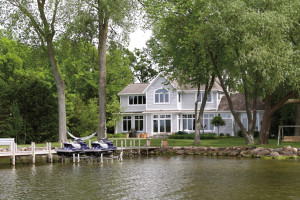 Living on Smith Mountain Lake is a reality for some, and a dream for many more. Who among us hasn’t fantasized about watching the seasons change and the sun set over the water from the comfort of our own deck?
Living on Smith Mountain Lake is a reality for some, and a dream for many more. Who among us hasn’t fantasized about watching the seasons change and the sun set over the water from the comfort of our own deck?
Full-time lake living may not be possible or practical for a variety of reasons. There could be a busy career that can’t permanently relocate to the shores of Smith Mountain Lake. Kids might need shuttling to far-flung activities. Retired snowbirds may need or want to divide time between more than one location. Perhaps we have Champagne dreams but more of a Prosecco budget. This is where the idea of fractional ownership comes in.
Wait a second—is that like a timeshare? Not quite. With a timeshare, you might spend a week or two per year at a vacation property, and you’ll be sharing it with many other partners. With fractional ownership, however, you’re part owner of the property itself, not just the vacation time you spend there. This comes with the increased responsibilities of homeownership, but multi-family ownership is a great option for those who want more of a second home than simply an annual vacation experience. It’s also used by many for investment purposes.
 Like most desirable locations, prime real estate in Smith Mountain Lake can be hard to find and prohibitively expensive. While the concept of fractional ownership is on the rise both nationally and globally, it is a new trend at Smith Mountain Lake. Most of us are familiar with the idea of fractional ownership involving family members: Mom and Dad buy a vacation home, which eventually passes down to siblings, and so on from there. In these cases, it’s a good bet that wills and lawyers ironed out most of the details when the property exchanged hands. But what if you and a friend or family member are considering purchasing a vacation home together, and are starting from scratch? Such was the case with Mark and Jennifer McLaughlin of Lynchburg.
Like most desirable locations, prime real estate in Smith Mountain Lake can be hard to find and prohibitively expensive. While the concept of fractional ownership is on the rise both nationally and globally, it is a new trend at Smith Mountain Lake. Most of us are familiar with the idea of fractional ownership involving family members: Mom and Dad buy a vacation home, which eventually passes down to siblings, and so on from there. In these cases, it’s a good bet that wills and lawyers ironed out most of the details when the property exchanged hands. But what if you and a friend or family member are considering purchasing a vacation home together, and are starting from scratch? Such was the case with Mark and Jennifer McLaughlin of Lynchburg.
About five years ago, Mark and Jennifer purchased a fixer-upper on Smith Mountain Lake with their friends. Avid lake enthusiasts (Mark is a barefoot water-skier), for some time they’d been driving up to the lake from the Boonsboro area and launching their boat from a public landing. They often brought along their teenage son’s good pal, whose parents they had become friends with through school. In the summer of 2009, they invited the other family to share a rental house on the lake. Through the course of their stay, the McLaughlins mentioned that they wanted to purchase property on the lake and had looked at a condo, but the deal fell through. The two couples tossed around the idea of buying a house together, and when the perfect property came on the market, they made an offer, and suddenly found themselves the co-owners of a lake house. Great news! Now what?
 Figure Out Finances
Figure Out Finances
First, let’s talk finances. When purchasing a multi-family home, you’ll want to set up a collaborative system for handling the financial aspects, including both the monthly mortgage payments and other bills. Sit down with your partners and draw up an annual budget of recurring and anticipated expenses. Will that roof need to be replaced soon? Is the dock in good shape? Does the home need any interior renovating? Decide if you’re going to hire services for landscaping, cleaning and the like. A cleaning service means no one has to spend their last day of the weekend cleaning, or worry about different standards of housekeeping. Don’t forget to pad your budget with a little reserve for unexpected items.
Once you know your overhead, determine how you want to manage the payments. It’s important to understand each partner’s perspective and priorities here, and figure out what works best to keep everyone on the same page. Automatic payments can keep mortgage and recurring payments running smoothly, and you can work out a system for sharing additional costs that arise. Perhaps you’ll keep track of receipts and settle up on a quarterly or semi-annual basis. Or maybe families will divide expenses by category. There are many different approaches to consider, and the most important thing is to come to an arrangement that makes sense for you. The McLaughlins established a joint checking account with their partners. Each family transfers money into the account, which is set up to auto-pay the mortgage and recurring bills. Each partner also has a check card to use for expenses (such as repairs) that arise.
 Booking Vacation Time
Booking Vacation Time
The next key step is determining usage rights, which will help define the rest of your arrangement. You may plan to spend a lot of your time there together, or you may want to divvy it up, depending upon your needs and wishes. In the event that one party is contributing more capital, it’s only fair that they get a proportional say in the time spent at the vacation home. If both parties are equal contributors, sit down together and draw up a schedule that works for everyone. If one family gets the Fourth of July, perhaps the other family will have Memorial and/or Labor Day weekends. Let’s say one family wants to be there for the fishing tournament or boat show, maybe the other will take Lake Pirate Days. If there’s a particularly desirable week on the calendar, offer to alternate years of who gets it. Set a schedule but allow for flexibility, because there’s sure to be some date trading.
Don’t forget to discuss rentals. Will you be using the home regularly, or will there be stretches of vacant time when some rental income would be welcome? If you’re open to the idea of renting out the property, decide how this process will be handled. Does someone in your party want to take on the responsibility of listing and renting your house via websites such as VRBO and Homeaway, or would you rather hire a vacation management company to handle the details? Either way, you’ll need to talk about rules for renters, such as pets, smoking, capacity and use of amenities.
 Outfitting Your Home
Outfitting Your Home
Once you’ve got the budget and the calendar in order, you can focus on design and décor. If your new home needs work, you’ve probably already gone over some basic renovation plans when setting up your budget. Develop and prioritize a project list, and figure out how much you can tackle yourself, and where a professional will be necessary. For do-it-yourselfers, work to your strengths. Divide tasks by skill and inclination as much as possible. Someone who’s handy with a paintbrush could do the painting, while someone who has some experience with plumbing or electrical issues could pitch in with installing a new faucet or lighting fixture. It’s also great to have an organizer in the group who can make sure supplies are on hand and coordinate schedules.
Think about how you want to handle the furnishings, while considering the layout of your home. Individual styles are likely to vary, so it’s probably best to stick with mostly neutral décor, and ensure that any later additions get group approval first. Make a list of the items you need to get your basic set-up established. Some things, such as kitchen utensils and dishware, often can be donated from a family’s primary residence. Big-ticket items like sofas and beds might need to be purchased. If shopping is required, approach this with an established budget and a flexible attitude. Jennifer McLaughlin and her friend went on a couple of shopping trips together to choose their sofas, rugs and guest bedding, but notes, “If any of us had extra stuff in our homes, we donated it to the lake house.”
 Finally, make sure you discuss what will be shared and what will be kept separate. This is especially important if your home will be open to renters. Will you need an “owner’s closet” to store your personal gear, or just share and share alike? The McLaughlins share food pantry staples and co-own a jet ski with their partners, but each family has their own boat. Talk about how to make sure your home is stocked with food staples and paper goods, and work out a system that is fair and agreeable to all parties.
Finally, make sure you discuss what will be shared and what will be kept separate. This is especially important if your home will be open to renters. Will you need an “owner’s closet” to store your personal gear, or just share and share alike? The McLaughlins share food pantry staples and co-own a jet ski with their partners, but each family has their own boat. Talk about how to make sure your home is stocked with food staples and paper goods, and work out a system that is fair and agreeable to all parties.
As you might have guessed, you’ll want to engage the services of a real estate attorney to draw up a contract that includes all these factors. Even if you handle arrangements informally, it’s wise to have rules to fall back on. A contract will also lay out an exit strategy in the event that one partner is no longer able to continue the arrangement.
Ultimately, the key to success with multi-family ownership is communication and consideration. Know your own needs and personality going in, but be open-minded to different styles of management. If you find a like-minded partner and can approach fractional ownership with realistic expectations and a flexible outlook, before long, you might find yourself sipping Prosecco on your very own lakeside dock.
FRACTIONAL OWNERSHIP CONSIDERATIONS AT A GLANCE
PAYMENT PLAN: Auto pay keeps things running smoothly.
SERVICES: Maintenance, repair, cleaning. Agree on how these things will be handled.
USAGE RIGHTS: Set up a calendar. Focus on fair
and flexible.
RENTALS: Yay or nay?
FURNISHINGS: Do you want group approval, or can one party take charge?
YOURS vs MINE: Share everything, or keep personal items separate?
EXIT STRATEGY: Decide what happens when circumstances change.
LEGALITIES: Talk with a lawyer to set up your contract.
